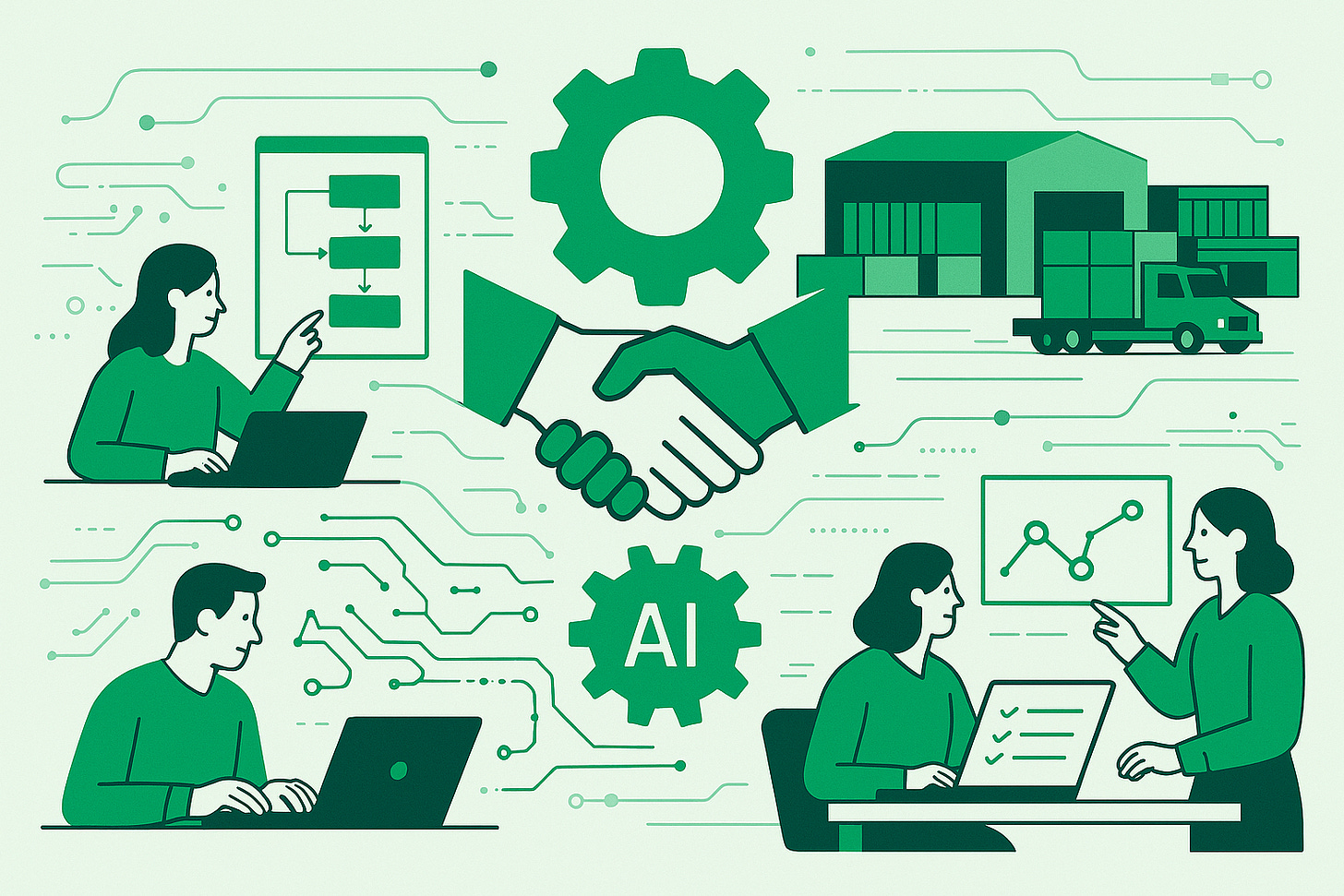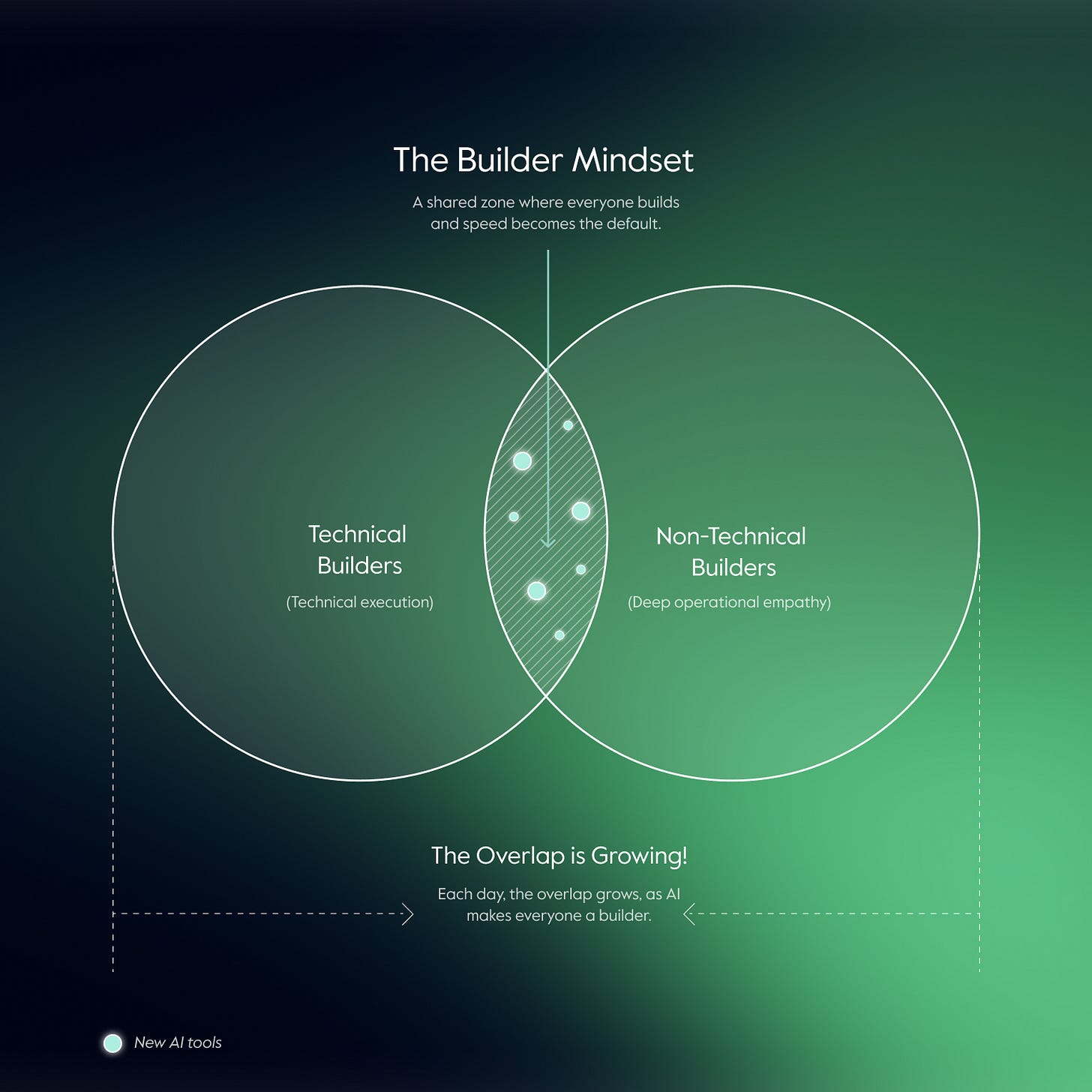#7: How to foster a culture of builders in the age of AI
Learn the tactical things we've done at Nuvocargo to build a culture that can effectively embrace AI. Read on for actionable tips that you can apply in your business and team.
As I’ve published more Substack posts, I’m repeatedly asked how Nuvocargo continues deploying AI so quickly across so many areas of our business & our platform- NuvoOS.
While there are many answers to that question, today’s post is about one of the most important pillars for embracing AI in 2025: fostering a culture of builders.
Every day at Nuvocargo we speak with shippers, manufacturers, and even private equity firms that own shippers. They all ask us similar questions:
How can I build a culture where all my teams embrace AI?
How can I deploy AI with real ROI?
Should I aim to build AI internally or partner with AI startups & 3rd parties?
How do you approach budget and experimentation with AI vendors?
The only constant in technology is change. Today with AI, the pace of change is faster than ever before. The only real way to keep up and adapt is having a culture that embraces change instead of getting steamrolled by it.
In this post I’m sharing very specific things we’ve done at Nuvocargo to build a culture that has allowed us to embrace AI with many examples of quantifiable impact and positive ROI.
We will cover:
Should you build on LLMs yourself or buy AI tools from 3rd parties?
What is a “culture of builders?”
Talent required to embrace AI
Why small teams with a lot of autonomy & speed win
How to evaluate and partner with AI startups
Budgets for experimentation with AI
Frequent company-wide demos to show what’s possible
Executives: spend time learning & thinking about the future
The post is meant to be helpful to shippers, manufacturers, or private equity firms that own shippers; it’s also relevant for startups looking to reinvent service businesses with AI.
Build internally or buy from 3rd parties?
One of the first questions we get from companies trying to embrace AI is whether or not to build on top of LLMs themselves or rely on startups and other AI vendors.
Since Nuvocargo sits at the intersection of retail/CPG/manufacturing companies and Silicon Valley startups, we have a unique lens into the pros & cons of these approaches depending on what kind of business you are.
Over time, we have developed strong conviction that if you are a company where technology is not your primary differentiator or product offering, then you should heavily bias towards partnering with 3rd parties for AI adoption. This is especially true if you are just beginning to explore how AI can impact your business.
Building technology is complex, expensive, and requires a lot of things to go right for you to see real ROI. Its especially hard if technology is not already in your company’s core DNA.
The main reason we advocate for partnering with third parties is that we are living through an unprecedented boom in new AI startups and established technology companies layering AI onto their core products.
These are technical teams building on the cutting edge, moving super fast, and aggressively seeking traction with customers to validate their new products & features.
If you are effective at evaluating and partnering with the right vendors, you will learn very fast with a much smaller investment and with a lot less risk.
If you position yourself as a helpful business to startups or technology companies (more on how to do this below), you can learn a lot and get a lot of valuable work done with them as partners in a way that is much cheaper & faster than building yourself.
What is a “culture of builders”?
Simply put, a culture of builders at Nuvocargo means a culture where both technical and nontechnical folks think in systems and are empowered to solve problems for our customers and our internal teams with the latest technology.
As the power of AI and LLMs permeate most knowledge work globally, we believe it’s important to foster this kind of culture regardless of whether you are a tech company or a traditional retail business. LLMs can drive efficiencies across all knowledge work, not only in software products.
At Nuvocargo, being a builder means you can do two things really well:
A) Diagnose issues in our processes and workflows
B) Build prototypes and first versions of AI and software tools to solve said issues
Being a builder at Nuvocargo also means you’re constantly re-evaluating your workflows and processes, always pushing to find the most efficient ways to get work done so we can best serve our customers and our mission.
Lastly, a culture of builders is one where people are pushing themselves to deeply understand the new available technological capabilities.
New technology enables new ways of doing things that were not possible in the past. If you don’t make an effort to deeply understand new technologies, your imagination will be handicapped; you won’t be able to see the future possibilities when re-thinking how to improve products, workflows, and value propositions for customers.
How Nuvocargo fosters a culture of builders
1. Talent required to embrace AI
After many years working to transform a legacy service business with software & AI, we have learned that talent is one of the core tenets to really begin this process.
In short, we’ve built teams of smart generalists who are willing to roll up their sleeves and get extremely close to the business. These folks are willing to temporarily take on the service and operations work themselves, and then zoom out to help map workflows and rethink processes for the future with technology.
In terms of talent profiles, our builders come from a mix of roles you would traditionally think of as BizOps or Product Managers.
This year, we actually merged our BizOps and Product teams which we think is a trend that will happen across tech companies as AI proliferates.
We found that BizOps teammates were willing to get very deep in the weeds on operations and build scrappy solutions, while Product has the complementary skills of translating user painpoints to design, engineering, and data science. Product and R&D folks in general tend to think more in scalable systems with a more technical approach which is crucial to building great software.
The combination of these two skillsets and mindsets is what you also might find in teams called “Applied AI” across other technology companies.
As you’ll see in the visual above, we really think both sides are necessary to innovate in a complex service business with real velocity. One without the other just doesn’t produce results in freight; I believe this is also true for most other trillion dollar service industries where AI is finally having a real impact.
If you are a shipper or private equity firm who is not building software internally, then I would index on finding smart generalists who have the skillsets closer to the BizOps side (non-technical builders).
Make those teammates in charge of getting close to the areas of your business you want to transform with AI. Let them lead evaluating new startups and vendors and give them some autonomy over budgets and picking the tools they are leaning into.
In general - let them run with their ideas with the ability to fail fast.
Even if your company does not build software and have engineers, you can treat these people as your “non technical builders” in the diagram above. Then, through partnerships - treat startups & 3rd parties as your technical builders and let them feed off each other to help transform the business.
2. Small teams with lots of autonomy & speed
One very important learning is that the key to innovation is to have small teams with high caliber talent (as described in the prior point), but also with full autonomy to decide how to rethink or improve a workflow. Its really hard to innovate by democratizing decisions or by consensus/committee.
If you put very talented people who are willing to get in the weeds, understand new technologies & what’s possible, and then give them autonomy to try things fast, you will have more shots on goal and quickly learn what works and what doesn’t. It doesn’t matter if some ideas fail - the failure should lead to learnings that eventually get you on the right path.
It is your responsibility as a leader to create the environment and expectations that allow for failure and experimentation.
Side note: If you are going to try to foster a culture of builders, you also need to try to do the hard work to eliminate busy work and unnecessary process wherever possible.
Here is a good essay from the founder of Y Combinator about this called Maker’s Schedule, Manager’s Schedule. Whoever you are tasking with trying to innovate and understand AI, in my view, should have more of a maker’s schedule rather than a manager’s schedule.
3. Evaluating & partnering with AI vendors & startups
As a YC company, we’ve been fortunate to get inbound outreach from tons of new AI startups since early 2023 when ChatGPT was just a few months old. What started as curiosity for the technology has morphed into a well oiled muscle in the company where we frequently evaluate new startups & vendors to make a well thought out build vs. buy decision.
The process of evaluating AI startups can be an enriching one with lots of learning. These startups are building at the cutting edge. They can show you what’s possible and help you further your technical prowess of what’s possible today that may have not been possible 1-2 years ago.
Startups love to give demo’s, structure low risk pilots, and build custom software for early customers who take a chance on them. Pro tip: startups like to call early customers who give them feedback “design partners.” Try to be a great design partner!
While startups can add a lot of value to your business - one less discussed topic is how terrible most companies are at working with startups. Being a startup ourselves at Nuvocargo, I can tell you that a company who has empathy for startups can get things done much faster at much lower cost than the company that makes every startup jump through a 6-12 month death spiral of a sales cycle.
Here are some tips so that startups want to work with you too:
Offer real feedback on their product: Position yourself as a company that will help AI startups and vendors validate new products & features with constant feedback. This way the startup gains feedback and you start learning at a lower cost.
Fast decisions: Be fast to make decisions, don’t drag things out. Startups think in days, not months or quarters. Set a clear point of contact, make timelines as clear as possible, and try to show clarity on your company’s decision making process before engaging too often with a startup. This will help your company infuse some urgency which your executives and management are likely to appreciate as well.
Clarity on budget: Be clear with your budgets and pricing up front to make sure you find vendors that meet your budgets on top of solving your needs.
Understand & communicate your use cases: Do the homework internally to study areas where new AI use cases can clearly drive positive ROI so your finance teams will easily approve pilots and experiments. Conveying 5 clear ideas to a startup of where you want AI to make a difference can save everyone months of open-ended abstract discussions.
Big caveat: After analyzing 100+ vendors since 2023, I can tell you that there is often a lot of excitement and dreams in the first mind blowing demo when you see an AI agent do something you felt was impossible to automate.
That feeling of awe is frequently followed by one of disappointment when your teams do more digging into the solution only to realize that a lot more custom work will be required to really make this work. LLMs can do a lot, but they are not a silver bullet and almost all startups know that custom work per customer is required given where the technology is today.
This is why you’ll find most AI startups employ teams called “forward deployed engineers,” which is fancy word for consultants who will do custom work until the technology is deployed in a way that actually works for your business.
On the point of startups possibly underwhelming you - I would advise you to avoid becoming a pessimist and a cynic. It’s easy to point out what doesn’t work today. It’s harder and more rewarding to squint and make things work so you can get an edge on your competition.
Everyone in Silicon Valley right now understands that AI and LLMs are on an exponential curve. They keep getting better and better.
Startups are getting better at deploying these products in a way that is enterprise ready too. While deploying these tools requires more effort today than it might in the future, that is precisely where you can still gain an edge over your competitors before these tools become extremely wide spread in the coming years and decades.
Below is a list of some (not all) startups & tools that we’ve loved working with to help push the envelope on deploying AI.
I believe all shippers, manufacturers, PE firms, and other nontechnical businesses can gain ROI and learn about AI by adopting these tools:
No-code workflows and integrations: Zapier and Airtable
AI workflow automation: Gumloop
AI agents build for nontechnical teammates: N8N
Software engineering: Cursor, Claude Code, and Codex
Vibe coding / rapid prototyping: Lovable, Replit, Supabase
Marketing / content: ChatGPT, Sora
There are many more AI tools we use at Nuvocargo, but this list of vendors has been widely adopted across our builders, both for technical and non-technical folks.
4. Budgets for experimentation with AI
One small thing here is I’ve seen some big companies try to be too prescriptive here for the sake of consistency and process.
Example: “For all AI tools, we only use Gemini because it comes with our G suite subscription.” That means any enthusiastic teammate who wants to try a new tool launched this week is often held prisoner to the “corporate AI policy of only using Gemini.”
While this makes high level sense, beware of stifling innovation and your team’s ability to be nimble in trying new tools as they launch.
Tools are changing very fast and new things are coming to market every single day. Different vendors are known for being stronger at different use cases.
You might want your engineers to lean into Claude Code and Cursor for AI software engineering, and let your marketing teams leverage ChatGPT, Sora, or Gemini. Try to create the space for experimentation in a way that accommodates your own budget.
I like to think of our AI experimentation budget as a way cheaper budget than hiring someone new in house to get a really good feel for what’s possible in the market. The ability to quickly try out new tools with low bureaucracy on approvals is part of what helps foster a culture of builders.
If you’re worried about vendor creep - you can set a reminder every 2-3 months to clean up & opt out of the AI tools that no one seems to be using or getting value from. Push for low cost and short-term pilots wherever you can until you have conviction a certain tool is worth the long-term investment.
5. Frequent company-wide demos to show what’s possible
One of the most powerful things culturally has been allowing our builders to proudly showcase what they’ve been able to prototype and build to the whole company. These can be demos at all hands or demos every 2-3 weeks.
If presented correctly and in an engaging way, demos can help spark imagination across your company and spread ideas that improve your business like wildfire.
Tactical tip: I believe whoever is presenting these demos should be very engaging. They should also have at least 1 slide explaining: Why does this matter? Whose life is improving thanks to this? What is the expected quantifiable impact (time saved, money saved, customer outcome improved)?
Try to make the demos engaging and every week(s) can start molding your culture to one that is excited to truly embrace AI because the results start to feel tangible and consistent.
6. Executives: spend time learning & thinking about the future
This is a big one for me, but I’ve not seen a lot of writing on it. What has worked for me as CEO of Nuvocargo is to really get as deep and close as I can to the new possibilities with AI in freight; and then zoom out on the weekends and try to think “What do these new capabilities mean for our business model and our customers? What is possible now that wasn’t possible before?”
Here are a few conclusions I’ve arrived at:
Business models: In most of B2B software, we are moving towards outcome based pricing or “selling work,” not SaaS pricing on a per seat basis.
AI enhances humans: Today its very clear to see how humans will significantly enhance their productivity with AI. I think its less clear to see how AI replaces humans entirely. This is especially true in an industry like freight. Think “my carrier reps will be able to book 5-10x the loads while doing less grunt work” instead of “I don’t need carrier reps anymore.”
Partnerships matter: In a world where we choose to partner with new startups and AI vendors, it pays to really think critically about who you are partnering with to run the core workflows of your business. Partnering with startups is amazing but it can also be risky. Before we make any startup or 3rd party a core part of our stack - we push ourselves to ask if we believe the vendor will be along for the ride as a great long-term partner.
Hope this helps you take some actionable steps to start fostering a culture of builders to deploy the extremely exciting power of AI!
If you are a shipper or involved with a shipper (such as via a private equity firm) and want to explore how we can help you adopt AI with positive ROI with NuvoOS, our AI native operating system for North America freight), please book a demo HERE.







Hey, great read as always, this idea of fostering a builder's culture for AI really resonats, kind of like how I approach mastering a new Pilates pose, with lots of small experiments and adapting until it clicks.